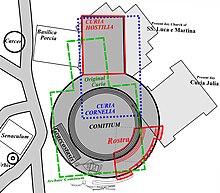Curia Hostilia

Curia Hostilia in red with the Republican Comitium diagram
|
|
| Location | Region VIII Forum Romanum |
|---|---|
| Built in | 7th century BC |
| Built by/for | Tullus Hostilius |
| Type of structure | Government building |
| Related | List of ancient monuments in Rome |
Coordinates: 41°53′35″N 12°29′07″E / 41.89306°N 12.48528°E
The Curia Hostilia was one of the original senate houses or "curia" of the Roman Republic. It is believed to have begun as a temple where the warring tribes laid down their arms during the reign of Romulus (r. c. 771–717 BC). During the early monarchy, the temple was used by senators acting as council to the king. Tullus Hostilius (r. 673–641 BC) is believed to have replaced the original structure after fire destroyed the converted temple. It may have held historic significance as the location of an Etruscan mundus and altar. The Lapis Niger, a series of large black marble slabs, was placed over the altar (known as the Volcanal) where a series of monuments was found opposite the Rostra. This curia was enlarged in 80 BC by Lucius Cornelius Sulla during his renovations of the comitium. The building burned down in 53 BC when the supporters of the murdered Publius Clodius Pulcher used it as a pyre to cremate his body.
There has been a meeting house for the people of Rome through most of Rome's history. This one likely began as a temple.
There may have been a small shrine to the god Vulcan from the earliest period, a stone altar with a marble stele inscribed with a dedication from a Latin King. An Honorary column was also among the tightly packed items. This spot was separated from the rest of the comitium with a low rising concrete fence to keep pedestrians from walking atop it.
...
Wikipedia

